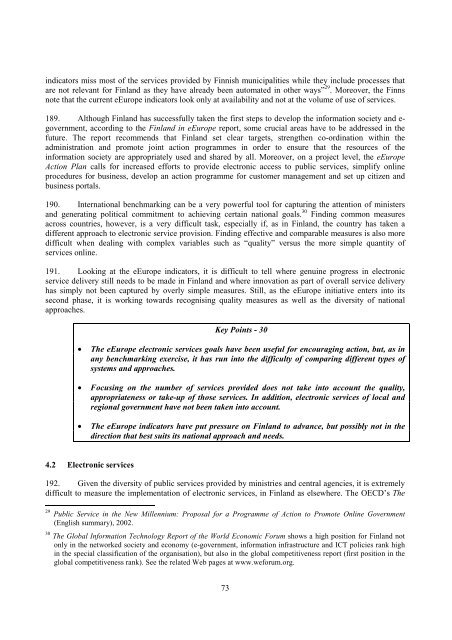e-GOVERNMENT IN FINLAND - ePractice.eu
e-GOVERNMENT IN FINLAND - ePractice.eu
e-GOVERNMENT IN FINLAND - ePractice.eu
You also want an ePaper? Increase the reach of your titles
YUMPU automatically turns print PDFs into web optimized ePapers that Google loves.
indicators miss most of the services provided by Finnish municipalities while they include processes that<br />
are not relevant for Finland as they have already been automated in other ways” 29 . Moreover, the Finns<br />
note that the current eEurope indicators look only at availability and not at the volume of use of services.<br />
189. Although Finland has successfully taken the first steps to develop the information society and egovernment,<br />
according to the Finland in eEurope report, some crucial areas have to be addressed in the<br />
future. The report recommends that Finland set clear targets, strengthen co-ordination within the<br />
administration and promote joint action programmes in order to ensure that the resources of the<br />
information society are appropriately used and shared by all. Moreover, on a project level, the eEurope<br />
Action Plan calls for increased efforts to provide electronic access to public services, simplify online<br />
procedures for business, develop an action programme for customer management and set up citizen and<br />
business portals.<br />
190. International benchmarking can be a very powerful tool for capturing the attention of ministers<br />
and generating political commitment to achieving certain national goals. 30 Finding common measures<br />
across countries, however, is a very difficult task, especially if, as in Finland, the country has taken a<br />
different approach to electronic service provision. Finding effective and comparable measures is also more<br />
difficult when dealing with complex variables such as “quality” versus the more simple quantity of<br />
services online.<br />
191. Looking at the eEurope indicators, it is difficult to tell where genuine progress in electronic<br />
service delivery still needs to be made in Finland and where innovation as part of overall service delivery<br />
has simply not been captured by overly simple measures. Still, as the eEurope initiative enters into its<br />
second phase, it is working towards recognising quality measures as well as the diversity of national<br />
approaches.<br />
Key Points - 30<br />
x The eEurope electronic services goals have been useful for encouraging action, but, as in<br />
any benchmarking exercise, it has run into the difficulty of comparing different types of<br />
systems and approaches.<br />
x Focusing on the number of services provided does not take into account the quality,<br />
appropriateness or take-up of those services. In addition, electronic services of local and<br />
regional government have not been taken into account.<br />
x The eEurope indicators have put pressure on Finland to advance, but possibly not in the<br />
direction that best suits its national approach and needs.<br />
4.2 Electronic services<br />
192. Given the diversity of public services provided by ministries and central agencies, it is extremely<br />
difficult to measure the implementation of electronic services, in Finland as elsewhere. The OECD’s The<br />
29<br />
Public Service in the New Millennium: Proposal for a Programme of Action to Promote Online Government<br />
(English summary), 2002.<br />
30 The Global Information Technology Report of the World Economic Forum shows a high position for Finland not<br />
only in the networked society and economy (e-government, information infrastructure and ICT policies rank high<br />
in the special classification of the organisation), but also in the global competitiveness report (first position in the<br />
global competitiveness rank). See the related Web pages at www.weforum.org.<br />
73
















